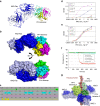Atomic description of the immune complex involved in heparin-induced thrombocytopenia
- PMID: 26391892
- PMCID: PMC4580983
- DOI: 10.1038/ncomms9277
Atomic description of the immune complex involved in heparin-induced thrombocytopenia
Abstract
Heparin-induced thrombocytopenia (HIT) is an autoimmune thrombotic disorder caused by immune complexes containing platelet factor 4 (PF4), antibodies to PF4 and heparin or cellular glycosaminoglycans (GAGs). Here we solve the crystal structures of the: (1) PF4 tetramer/fondaparinux complex, (2) PF4 tetramer/KKO-Fab complex (a murine monoclonal HIT-like antibody) and (3) PF4 monomer/RTO-Fab complex (a non-HIT anti-PF4 monoclonal antibody). Fondaparinux binds to the 'closed' end of the PF4 tetramer and stabilizes its conformation. This interaction in turn stabilizes the epitope for KKO on the 'open' end of the tetramer. Fondaparinux and KKO thereby collaborate to 'stabilize' the ternary pathogenic immune complex. Binding of RTO to PF4 monomers prevents PF4 tetramerization and inhibits KKO and human HIT IgG-induced platelet activation and platelet aggregation in vitro, and thrombus progression in vivo. The atomic structures provide a basis to develop new diagnostics and non-anticoagulant therapeutics for HIT.
Conflict of interest statement
The authors declare no competing financial interest but a patent has been filed on the use of the antibodies for HIT by the University of Pennsylvania. Zheng Cai, Douglas B. Cines, Zhiqiang Zhu and Mark I. Greene are listed as inventors.
Figures





References
-
- Phillips K. W., Dobesh P. P. & Haines S. T. Considerations in using anticoagulant therapy in special patient populations. Am. J. Health Syst. Pharm. 65, S13–S21 (2008). - PubMed
-
- Lewis B. E. et al.. Argatroban anticoagulation in patients with heparin-induced thrombocytopenia. Arch. Intern. Med. 163, 1849–1856 (2003). - PubMed
-
- Cuker A. & Cines D. B. How I treat heparin-induced thrombocytopenia. Blood 119, 2209–2218 (2012). - PubMed
Publication types
MeSH terms
Substances
Associated data
- Actions
- Actions
- Actions
- Actions
Grants and funding
LinkOut - more resources
Full Text Sources
Other Literature Sources
Medical
Miscellaneous

